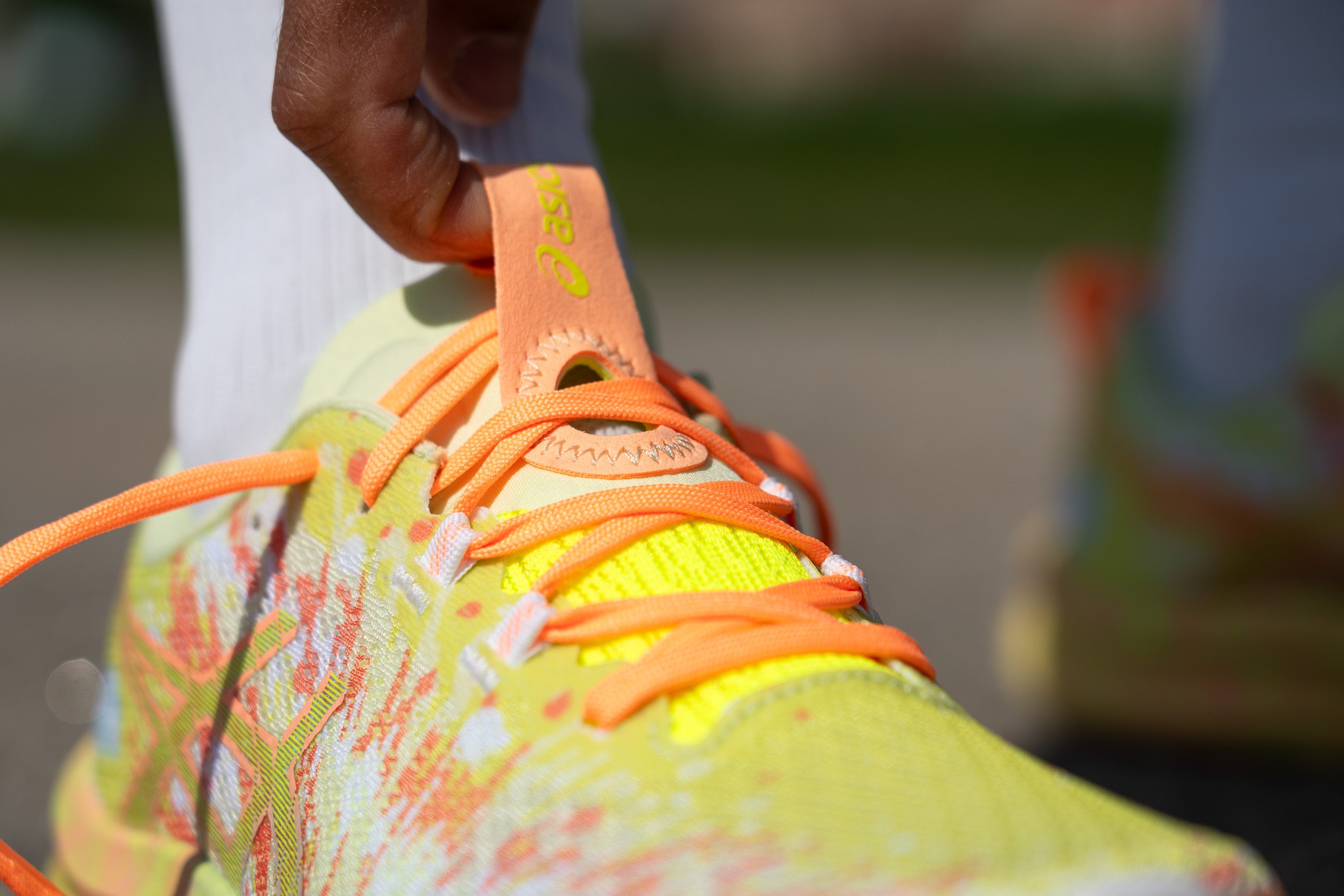Our verdict
- Top pick in best running shoes with a wide toebox
- Top pick in best Running shoes for 5K and 10K races
Pros
- Lightweight
- Exceptional grip
- Attention-grabbing aesthetic
- Gusseted tongue
- Comfortable upper
- Great for triathlon
- Really versatile
- Fantastic price point
- Breathability
Cons
- Upper longevity
- Minimal tongue padding
- Still not enough energy return
Audience verdict
Comparison
The most similar running shoes compared
+ + Add a shoe | |||||
|---|---|---|---|---|---|
| Audience score | 84 Good! | 92 Superb! | 85 Good! | 88 Great! | |
| Price | $135 | $125 | $140 | $90 | |
| Pace | Daily runningTempo | Daily running | Daily running | Daily running | |
| Shock absorption | Moderate | High | Moderate | Moderate | |
| Energy return | Low | Moderate | Low | Low | |
| Traction | High | Moderate | Moderate | High | |
| Arch support | Neutral | Neutral | Neutral | Neutral | |
| Weight lab Weight brand | 7.7 oz / 217g 7.6 oz / 215g | 10.1 oz / 285g 9.7 oz / 275g | 10.5 oz / 298g 11.1 oz / 314g | 9.2 oz / 261g 9.3 oz / 263g | |
| Lightweight | ✓ | ✗ | ✗ | ✗ | |
| Drop lab Drop brand | 5.9 mm 5.0 mm | 6.5 mm 6.0 mm | 5.2 mm 5.0 mm | 6.0 mm 6.0 mm | |
| Strike pattern | Mid/forefoot | Mid/forefoot | Mid/forefoot | Mid/forefoot | |
| Size | Half size small | True to size | True to size | True to size | |
| Midsole softness | Soft | Soft | Balanced | Balanced | |
| Difference in midsole softness in cold | Small | Normal | Normal | Small | |
| Toebox durability | Bad | Decent | Decent | Bad | |
| Heel padding durability | Good | Bad | Good | Decent | |
| Outsole durability | Decent | Good | Good | Good | |
| Breathability | Breathable | Moderate | Moderate | Breathable | |
| Width / fit | Wide | Narrow | Narrow | Medium | |
| Toebox width | Wide | Medium | Narrow | Medium | |
| Stiffness | Moderate | Moderate | Stiff | Stiff | |
| Torsional rigidity | Stiff | Stiff | Moderate | Stiff | |
| Heel counter stiffness | Moderate | Moderate | Stiff | Moderate | |
| Rocker | ✗ | ✓ | ✗ | ✗ | |
| Heel lab Heel brand | 32.8 mm 34.5 mm | 34.1 mm 38.0 mm | 33.2 mm 30.0 mm | 32.7 mm 29.0 mm | |
| Forefoot lab Forefoot brand | 26.9 mm 29.5 mm | 27.6 mm 32.0 mm | 28.0 mm 25.0 mm | 26.7 mm 23.0 mm | |
| Widths available | Normal | Normal | Normal | Normal | |
| Orthotic friendly | ✓ | ✓ | ✓ | ✓ | |
| Season | SummerAll seasons | All seasons | All seasons | SummerAll seasons | |
| Removable insole | ✓ | ✓ | ✓ | ✓ | |
| Ranking | #242 Bottom 34% | #7 Top 2% | #225 Bottom 39% | #133 Top 36% | |
| Popularity | #132 Top 36% | #269 Bottom 27% | #43 Top 12% | #274 Bottom 26% |
Who should buy
After extensive testing in the lab, we recommend the Noosa Tri 16 for:
- Runners who love vibrant styles, as it maintains the signature bold look at an amazing price point.
- Those in search of a super-lightweight yet cushioned daily trainer, perfect for balancing comfort with performance.
- Forefoot and midfoot strikers looking for a versatile shoe that does a great job during easy runs and tempo workouts alike.
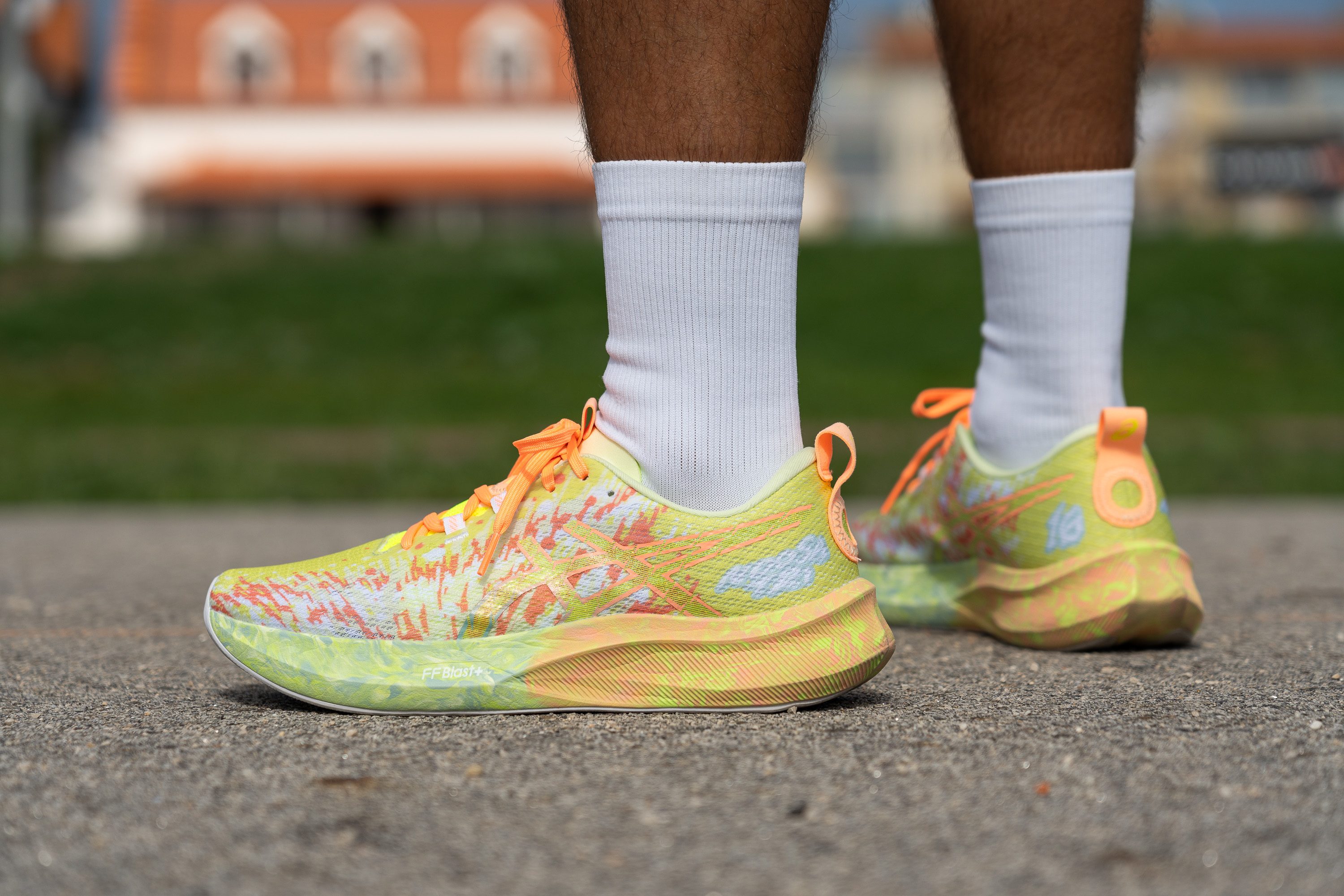
Who should NOT buy
While the Noosa Tri 16 shines in many areas, it may not be the ideal choice for heel strikers concerned with outsole durability due to its substantial amount of exposed midsole. For these runners, we recommend considering the Hoka Mach 6 as a more durable alternative that better suits their needs.
We found that the moderate heel stack height of the Noosa Tri 16 might not be ideal for runners planning to use it for longer distances. Instead, we suggest checking out the Adidas Adizero EVO SL or the ASICS Novablast 5. Both are similarly priced and deliver a super-cushioned ride with extra foam underfoot.

Cushioning
Shock absorption
Shock absorption sits right in the middle, just like a daily trainer. We think that’s a smart choice for the Noosa Tri 16, it avoids an ultra-thick midsole while still offering enough cushion to handle long runs when needed.
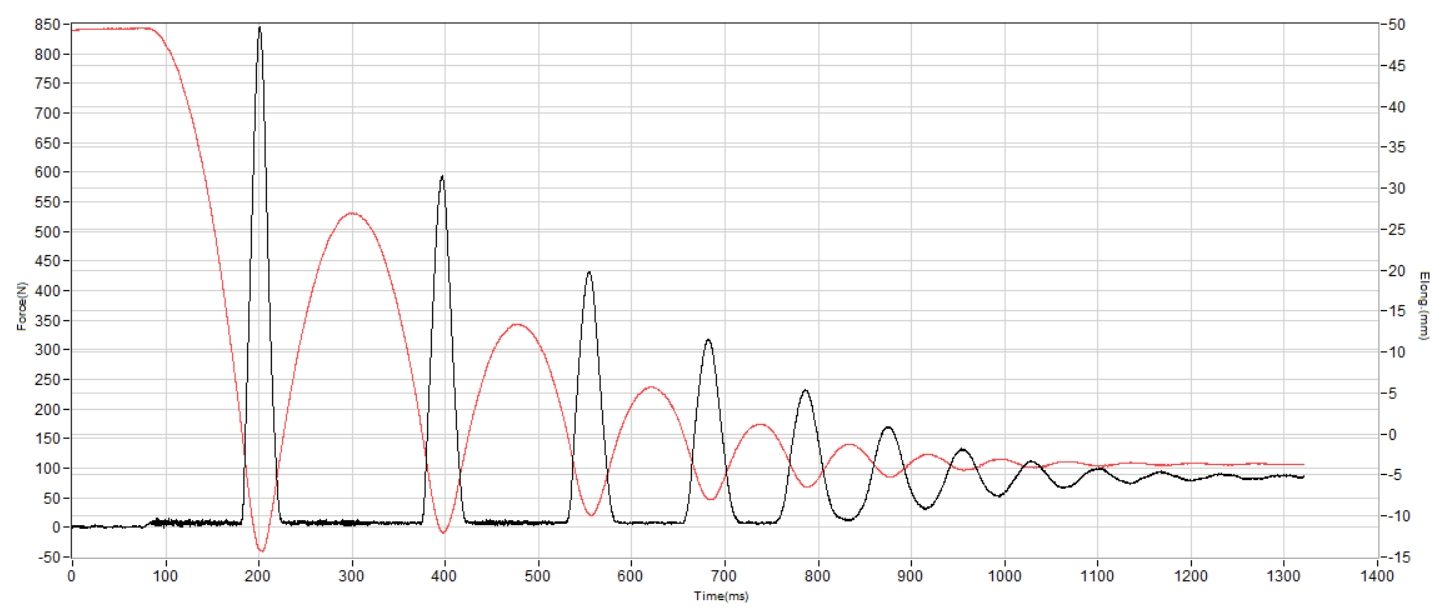
| Noosa Tri 16 | 129 SA |
| Average | 129 SA |
Energy return
The switch from FF Blast to FF Blast+ brought a jump in energy return compared to the previous version, now hitting 53.9% in the heel and 60.9% in the forefoot.
That forefoot result finally feels in line with what we’d expect at this price point, which is great news. Still, if ASICS wants this shoe to win over performance-focused runners, they’ll need to take it a step further. Time for FF Turbo+?
| Noosa Tri 16 | 53.9% |
| Average | 58.5% |
Heel stack
As shoes continue to grow in size each year, we're grateful that the Noosa Tri 16 still offers a classic feel underfoot with its 32.8 mm heel stack. It strikes the perfect balance between staying close to the ground and providing ample impact protection for short to medium distance runs.
We're hopeful that future versions of the Noosa will continue to deliver this same running experience.
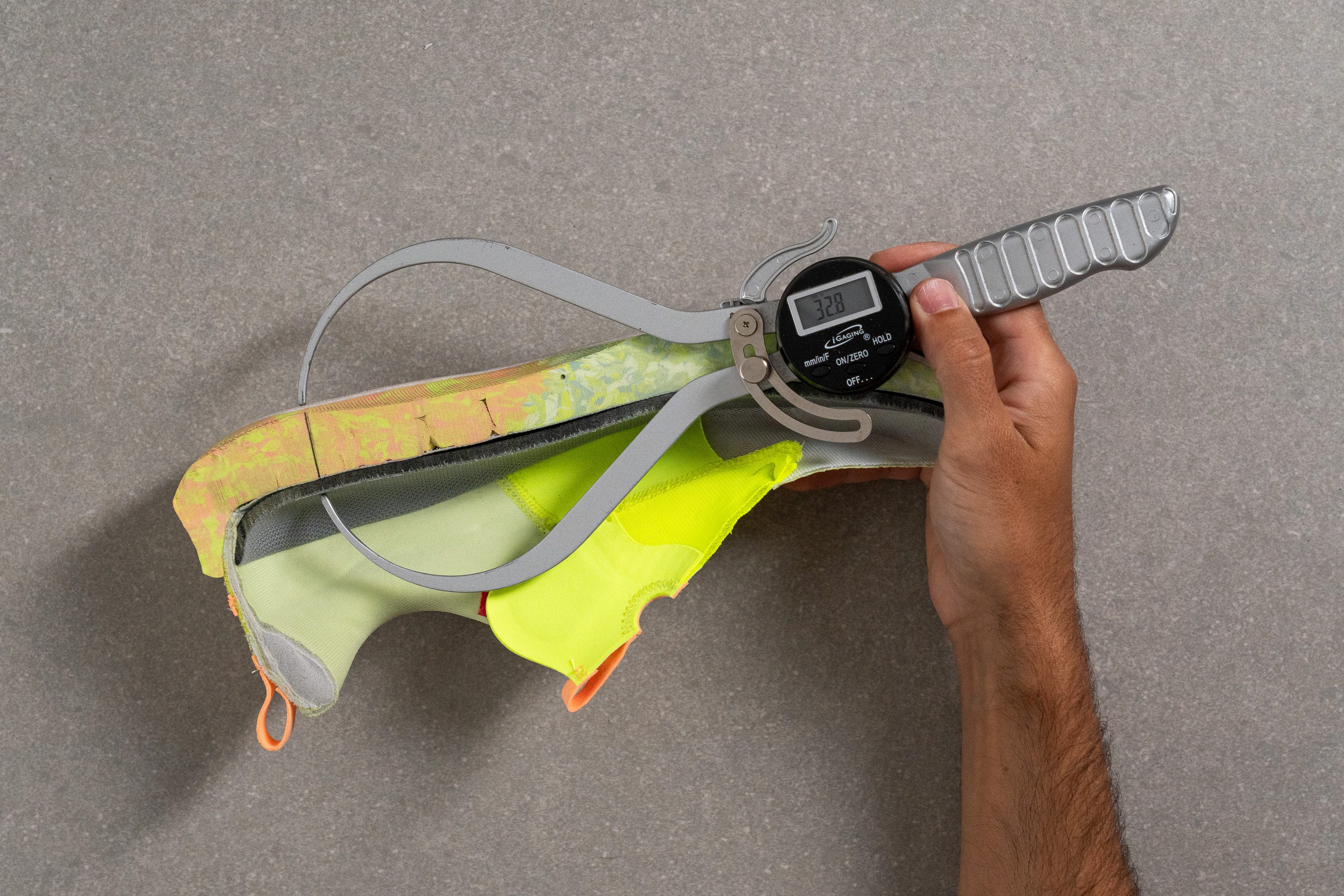
| Noosa Tri 16 | 32.8 mm |
| Average | 34.8 mm |
Forefoot stack
The forefoot of the Noosa Tri series enjoys a moderate drop, featuring an impressive 26.9 mm of cushioning in the front—more than many daily trainers. This makes the NT16 an excellent option for those looking for a super-lightweight, well-cushioned forefoot without the bulk.
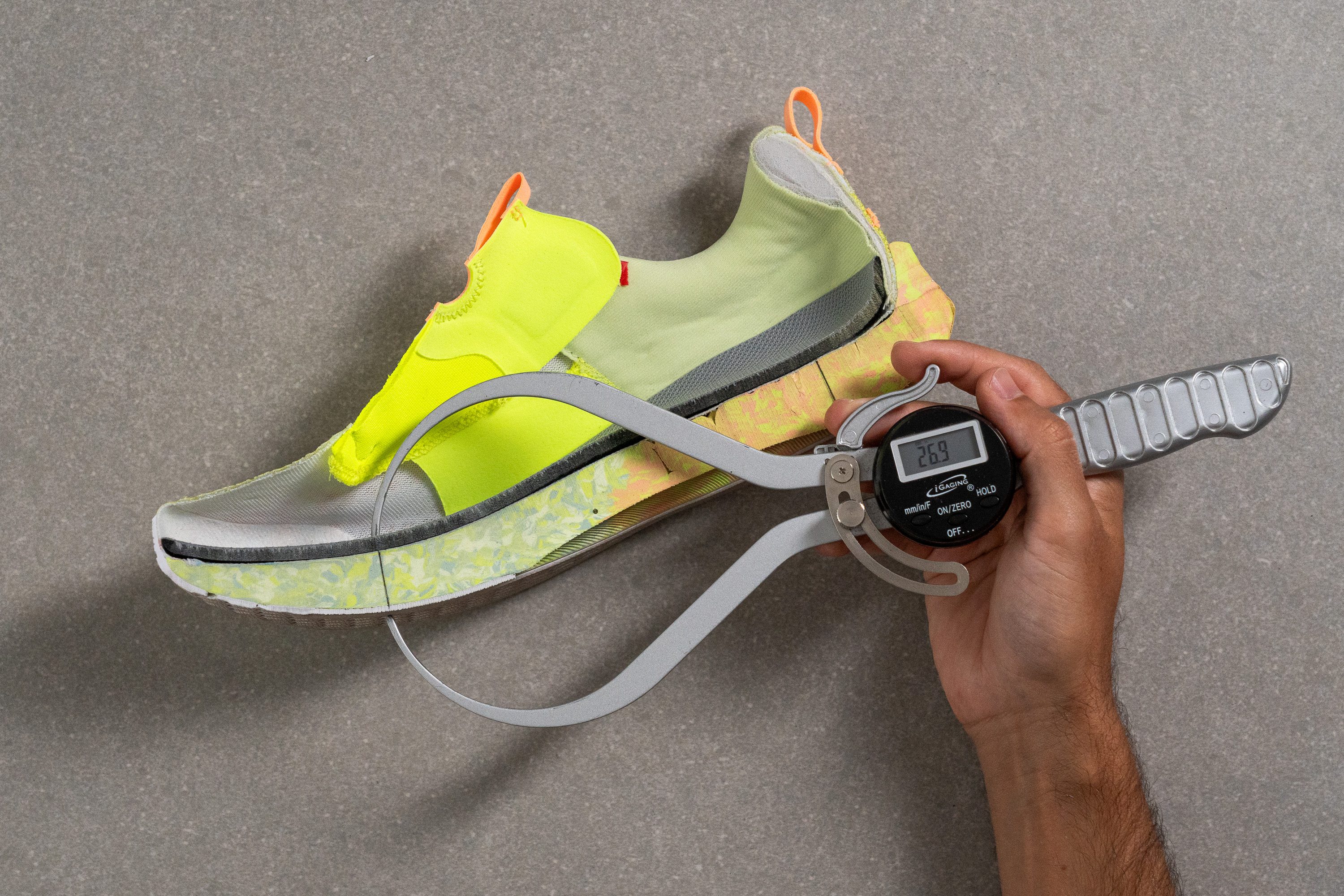
| Noosa Tri 16 | 26.9 mm |
| Average | 26.2 mm |
Drop
One standout feature of the Noosa Tri series is its medium drop geometry, which ASICS advertises as having a 5 mm offset.
We measured it at 5.9 mm, and with such a minor difference—less than 1 mm—we found no issues at all. For us, it remains a mid-drop shoe, performing exceptionally well for both forefoot and midfoot strikers.
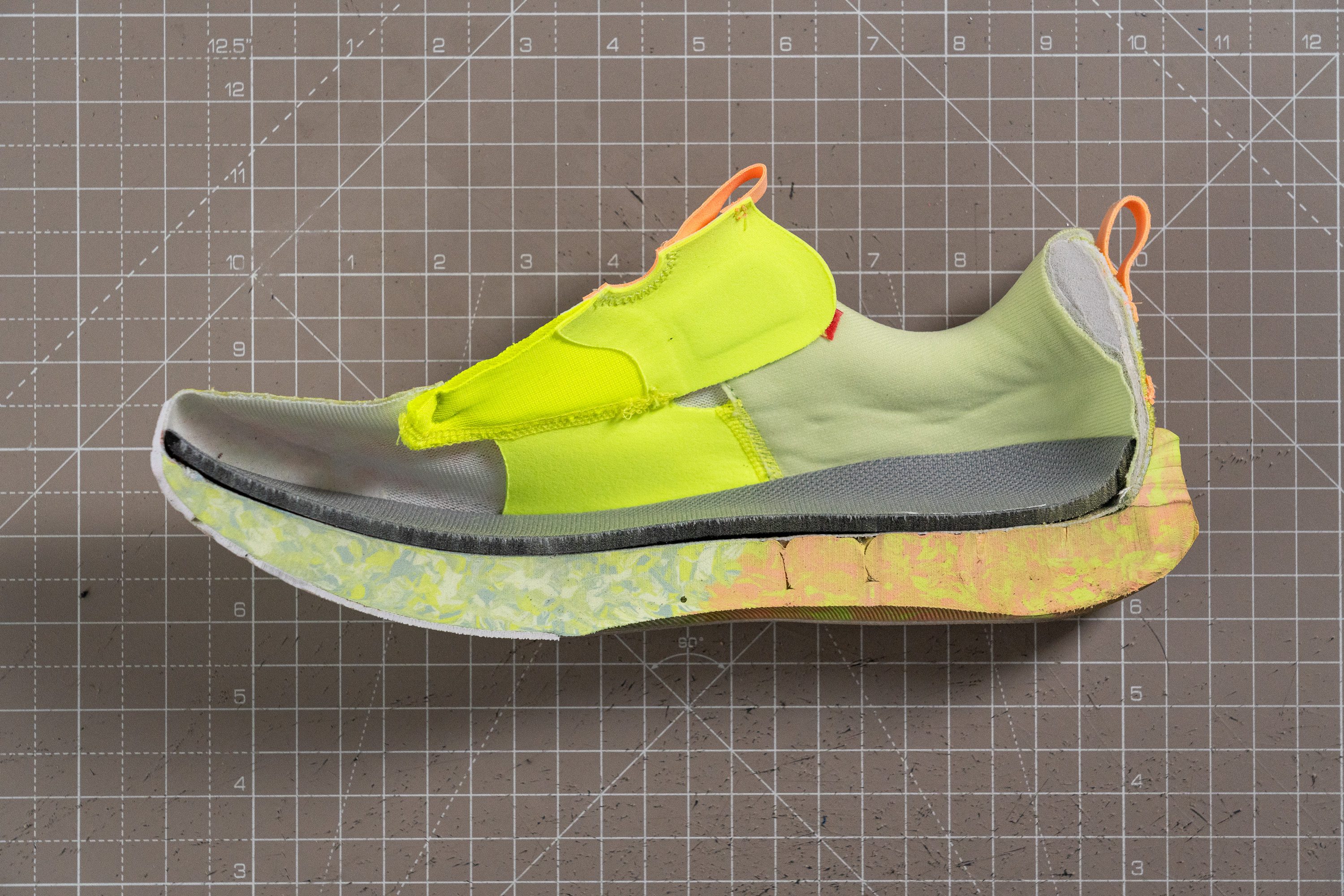
| Noosa Tri 16 | 5.9 mm |
| Average | 8.6 mm |
Midsole softness
Last year, while we were pleased with the FF Blast in the Tri 15, we felt it could improve.
With the Noosa Tri 16, along with a reasonable $5 price increase, we've welcomed a significant upgrade—the full-length FF Blast+ foam. This new formulation, despite the simple addition of a "+", offers much greater resilience, enhancing energy return significantly.
Although the FF Blast+ feels really similar to its predecessor, achieving a Shore A durometer score of 18.3 HA, the improved responsiveness marks a positive step forward.
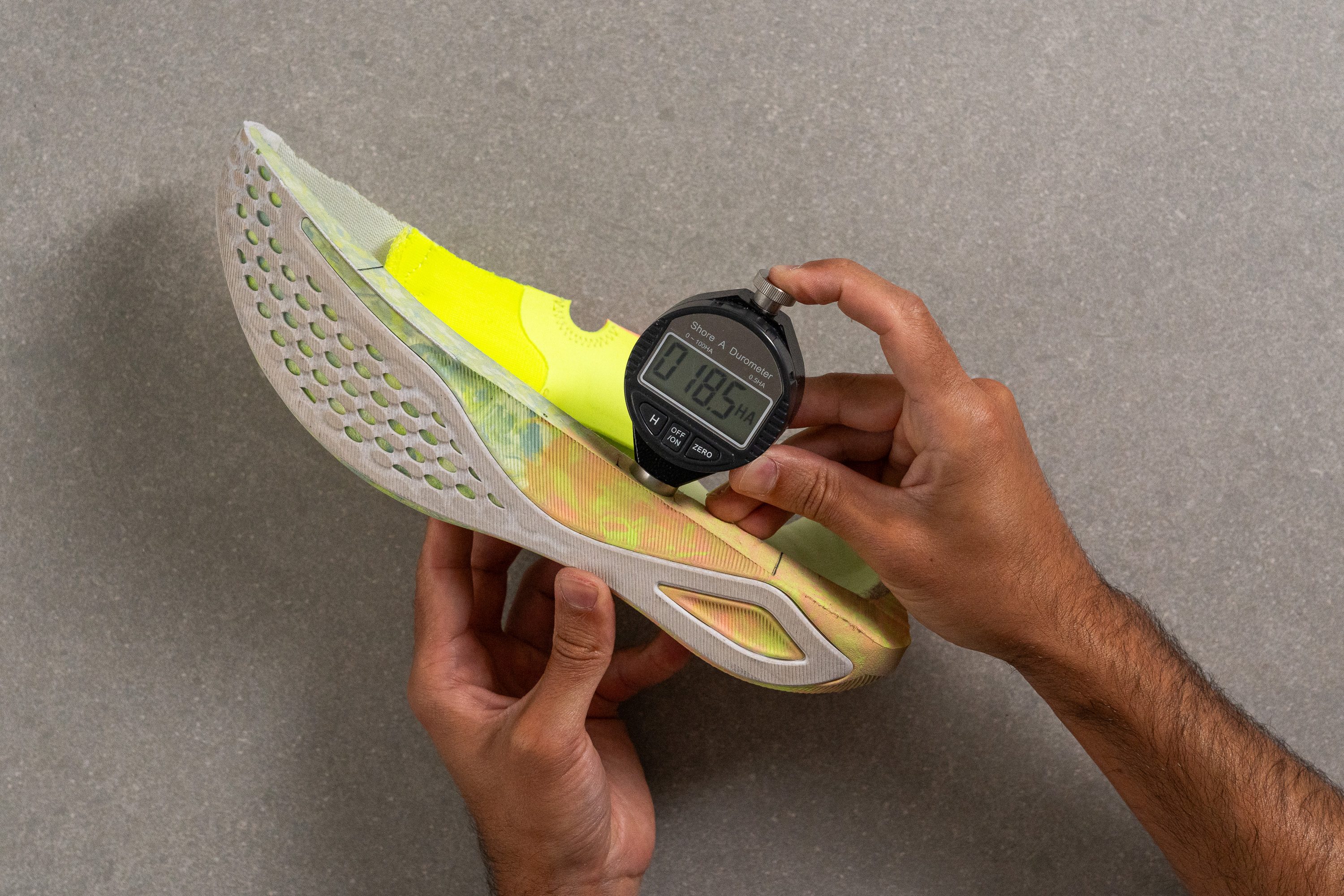
| Noosa Tri 16 | 18.3 HA |
| Average | 20.4 HA |
Rocker
Another standout feature of the Noosa Tri series is its classic ride, enhanced by a subtle rocker that aids in transitions without being overly dramatic. Nonetheless, we noticed a slight increase in the rocker at the forefoot compared to last year's model, which definitely improves performance at easy paces.
Size and fit
Size
ASICS Noosa Tri 16 fits half size small (166 votes).
Consider sizing up
Width / Fit
Right from the start, we slipped into the Noosa Tri 16 and felt it spacious, just like its predecessor, the Noosa Tri 15.
Our initial tests confirmed this, as we measured the width of our custom-made gel mold with digital calipers and recorded a max width of 98.6 mm.
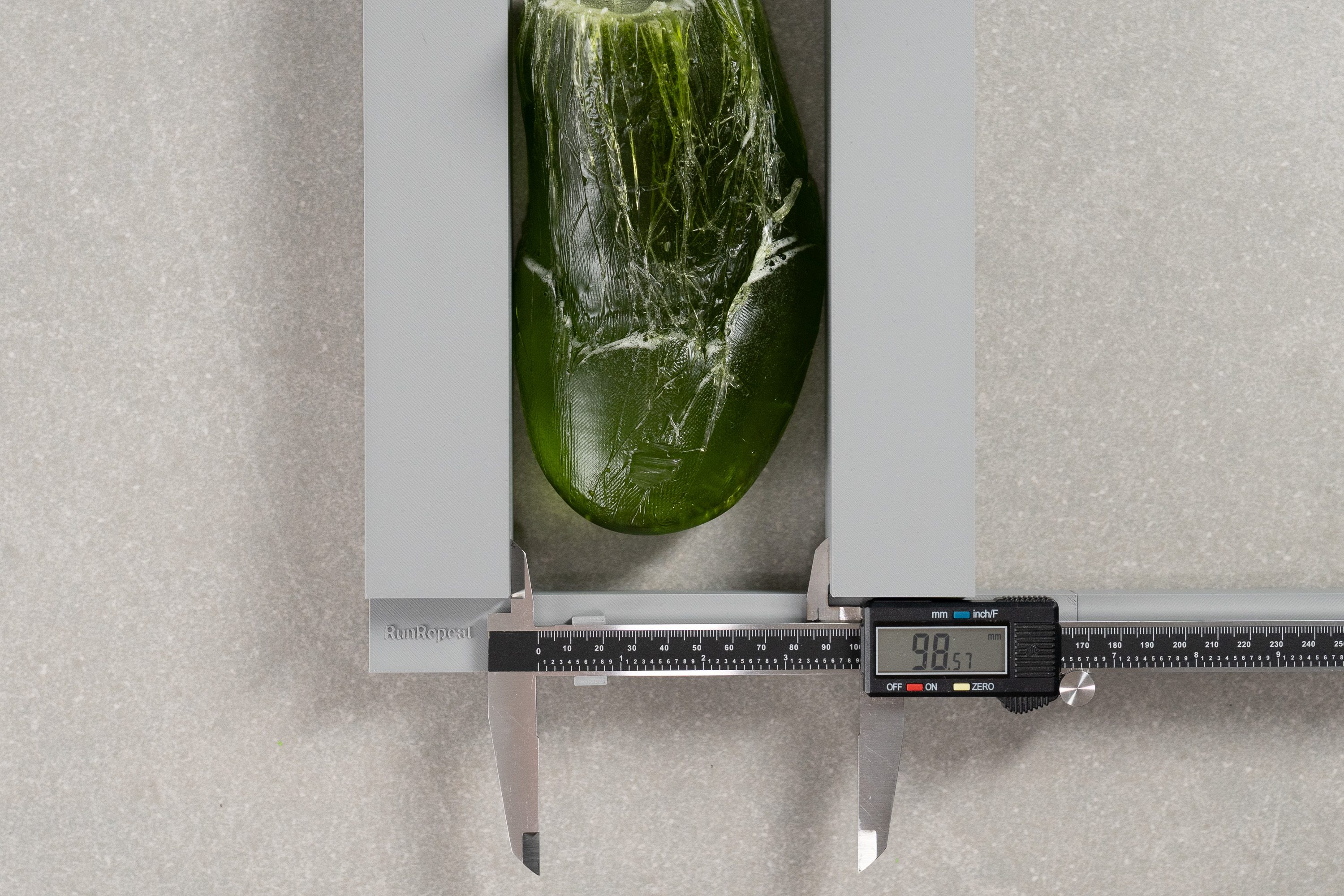
| Noosa Tri 16 | 98.6 mm |
| Average | 95.1 mm |
Toebox width
The big toe area in the new model is less tapered and more rounded compared to previous versions. Our second measurement confirmed this change, showing a fantastic width of 77.3 mm.
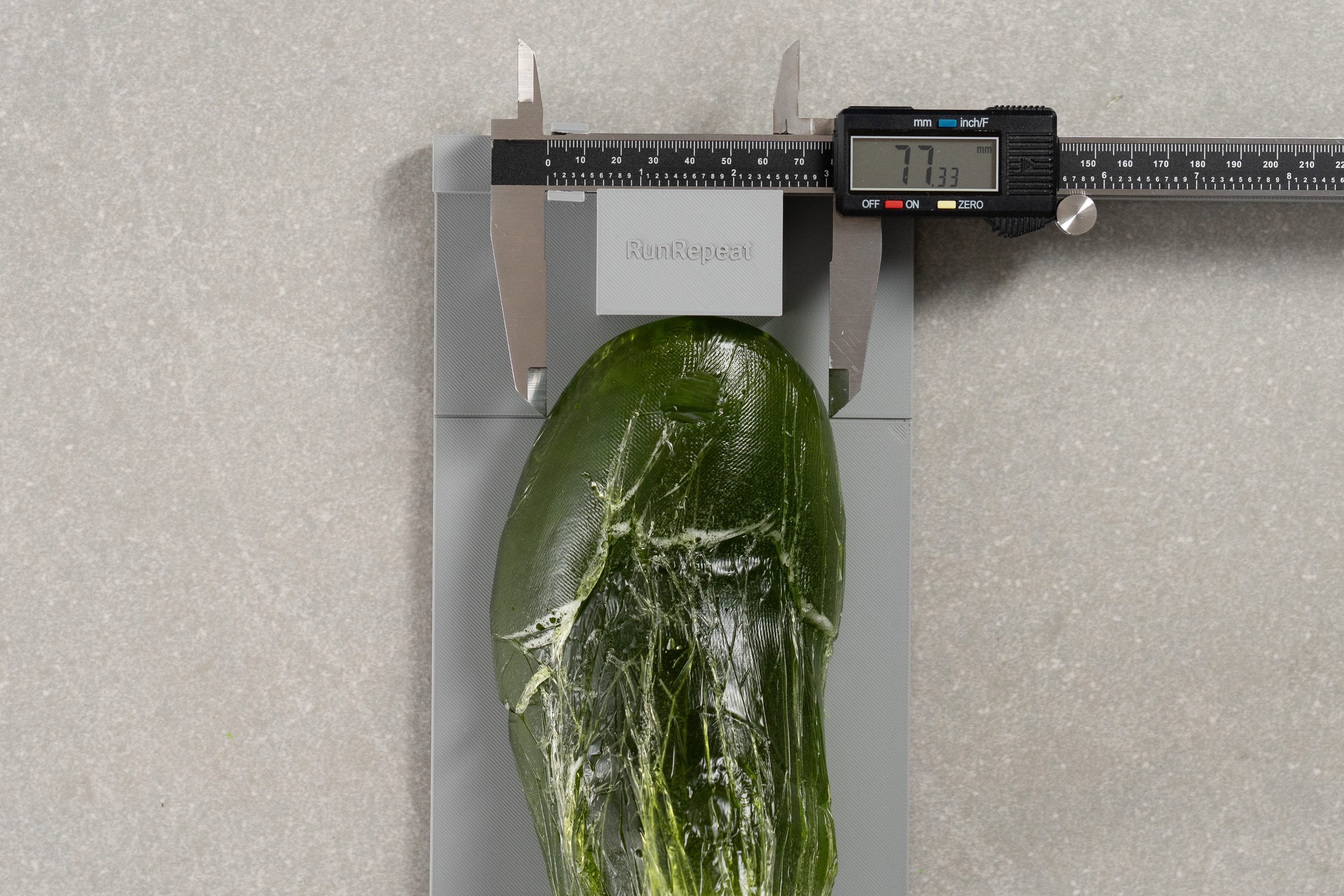
| Noosa Tri 16 | 77.3 mm |
| Average | 73.3 mm |
Toebox height
We also discovered that the toebox offers impressive vertical space, thanks to its rounded and taller-than-average toecap design.
We measured a generous 31.2 mm in height, exceeding most running shoe designs. However, this can be a double-edged sword—runners seeking a snugger fit for triathlon racing might find it less than ideal.
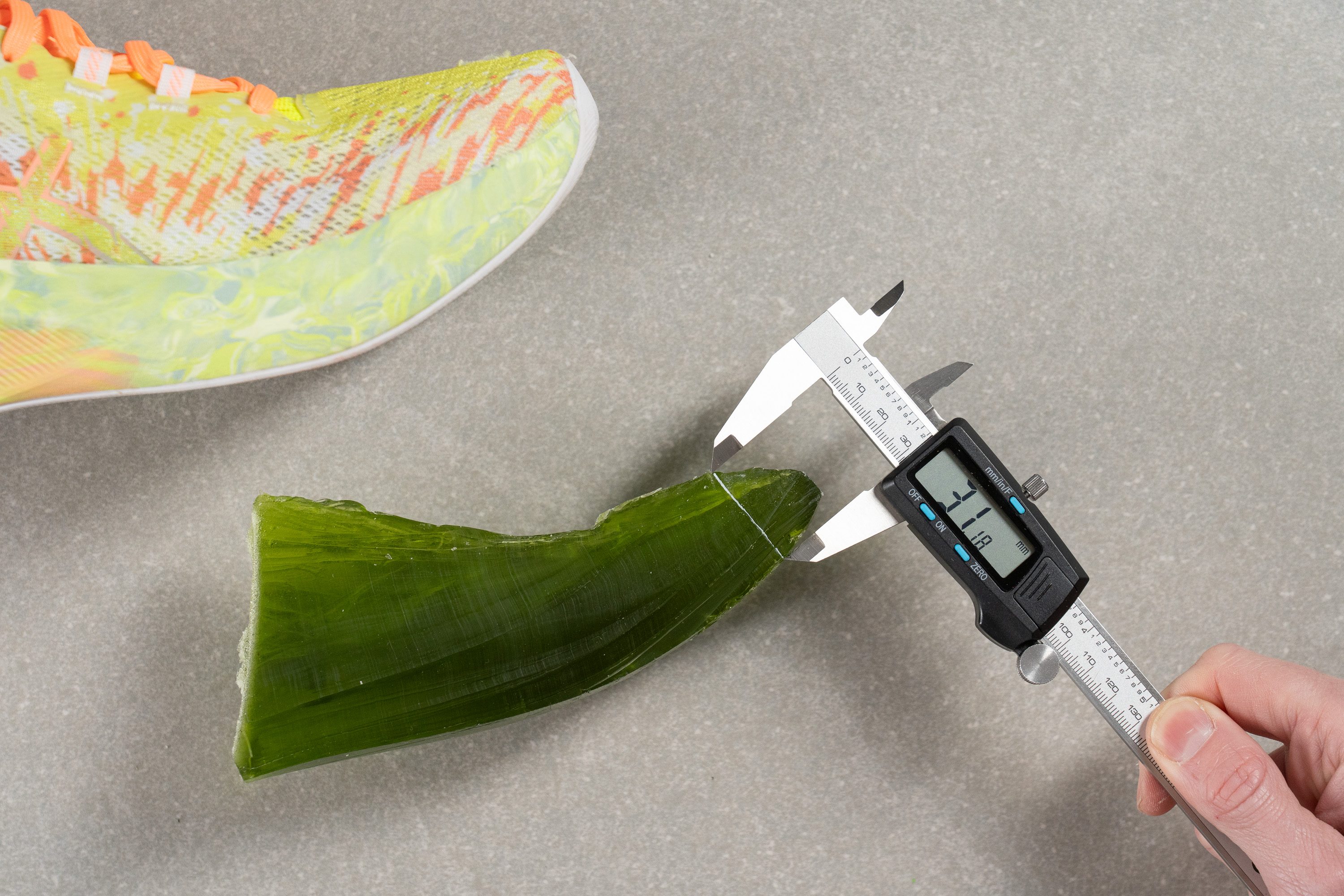
| Noosa Tri 16 | 31.2 mm |
| Average | 27.1 mm |
Traction / Grip
Traction test
Turning our attention to the outsole, we have some exciting updates. ASICS has incorporated its ASICSGRIP rubber—a highly effective, super-grippy material also used in the Metaspeed series and the exceptional Superblast 2. Previously, it used AHAR rubber, which wasn't top-tier by any means.
That definitely shows up in our grip test, where it scored a stellar 0.79—marking a huge improvement over its predecessor and ranking as one of the best shoes on the market.
| Noosa Tri 16 | 0.79 |
| Average | 0.48 |
Outsole design
The outsole coverage is good for such a lightweight shoe. We also appreciated the central groove in the forefoot, which enhances flexibility slightly.

Flexibility / Stiffness
ASICS has chosen not to include a plate in the Noosa Tri series, a decision we fully support. In a market flooded with shoes that offer a stiffer ride, it's refreshing to have options that provide a more natural, traditional feel.
In our lab, the Noosa Tri 16 exhibited a flexibility score of 14.6N in our 30-degree bend test—placing it in the average range and making it suitable for all kinds of runs.

| Noosa Tri 16 | 14.6N |
| Average | 15.3N |
Stiffness in cold (%)
After chilling the Noosa Tri 16 in the freezer for 20 minutes, our subsequent 90-degree bend test showed only a 15.4% increase in stiffness. This result is certainly encouraging, eliminating one less concern for us.
| Noosa Tri 16 | 15% |
| Average | 33% |
Weight
Weighing in at just 7.7 oz or 217g, the Noosa Tri 16 continues to be one of the lightest tempo running shoes available.
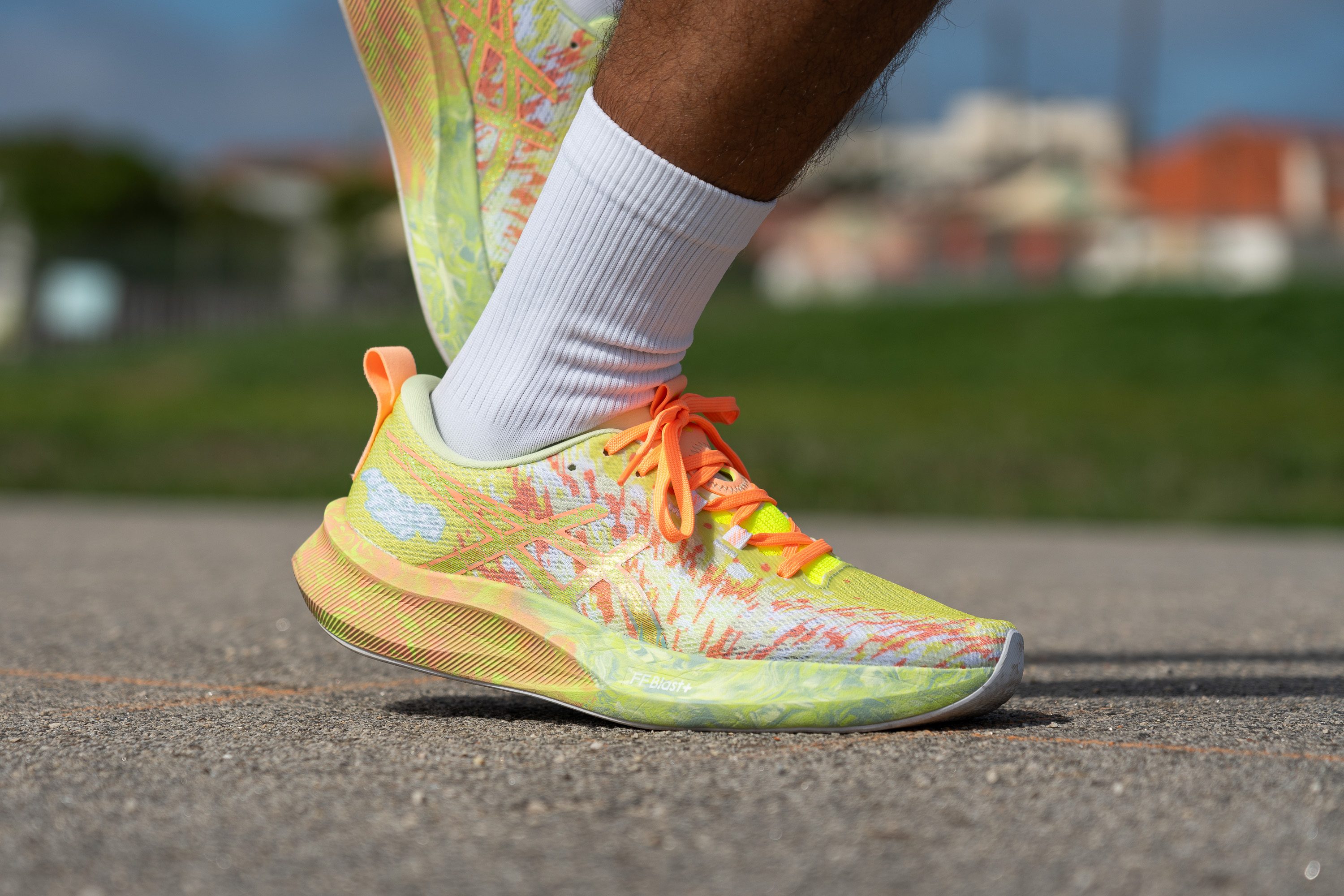
We absolutely love its nimble and responsive feel underfoot. This characteristic has become a hallmark of the series, and we sincerely hope ASICS maintains this feature for years to come, even as the trend keeps moving towards bulkier shoes.
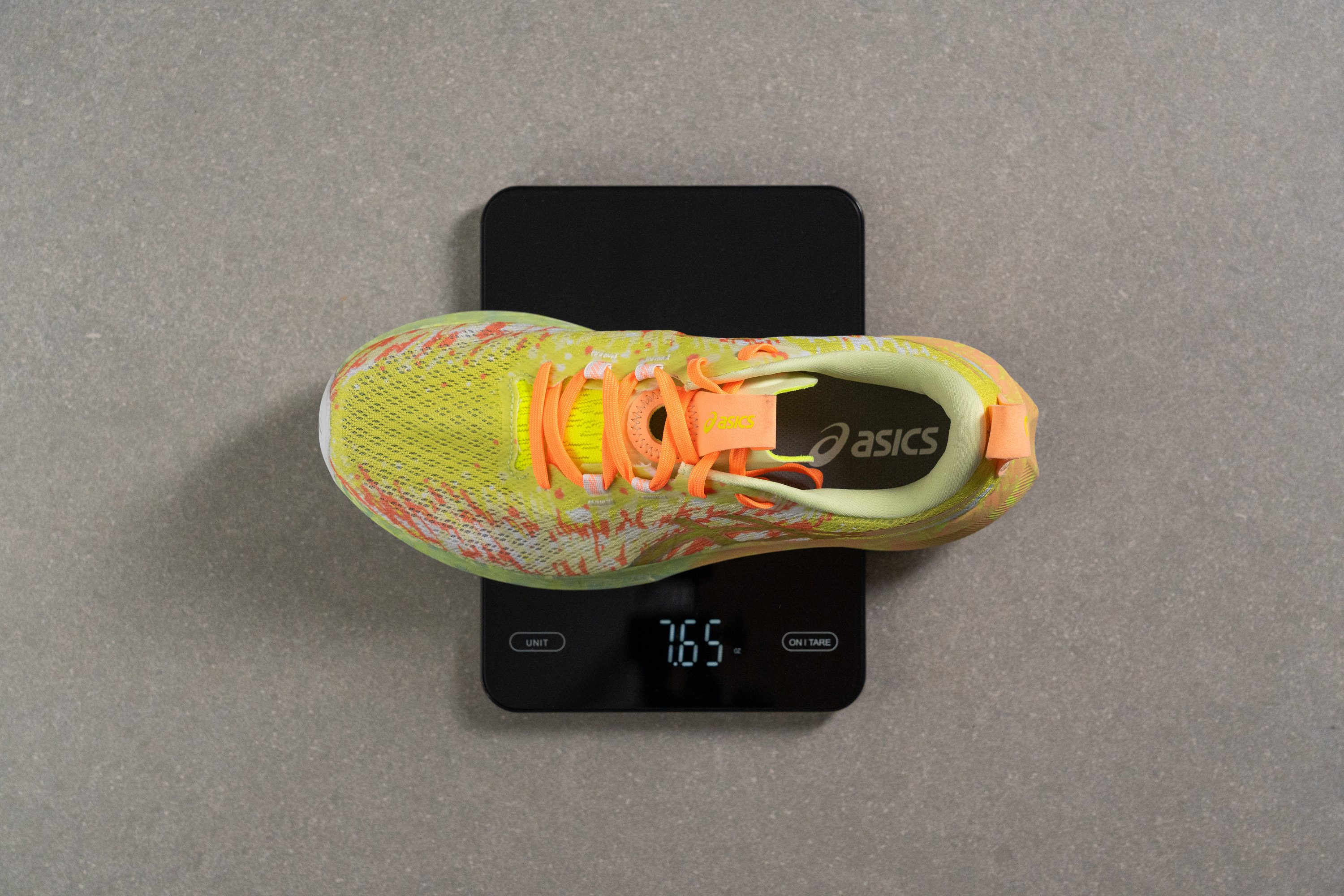
| Noosa Tri 16 | 7.7 oz (217g) |
| Average | 9.3 oz (264g) |
Breathability
The vibrant Noosa Tri 16 not only grabs attention with its bold design but also stands out for its exceptional ventilation, particularly in the toebox area, as demonstrated by our tests with a smoke-pumping machine.
It earned a perfect score of 5-out-of-5 for its exceptional breathability, prompting us to delve deeper into its unique features.
We discovered with our light that ASICS meticulously crafted the toebox to maximize airflow, while reinforcing the sides and heel to prevent lateral collapse and enhance support.
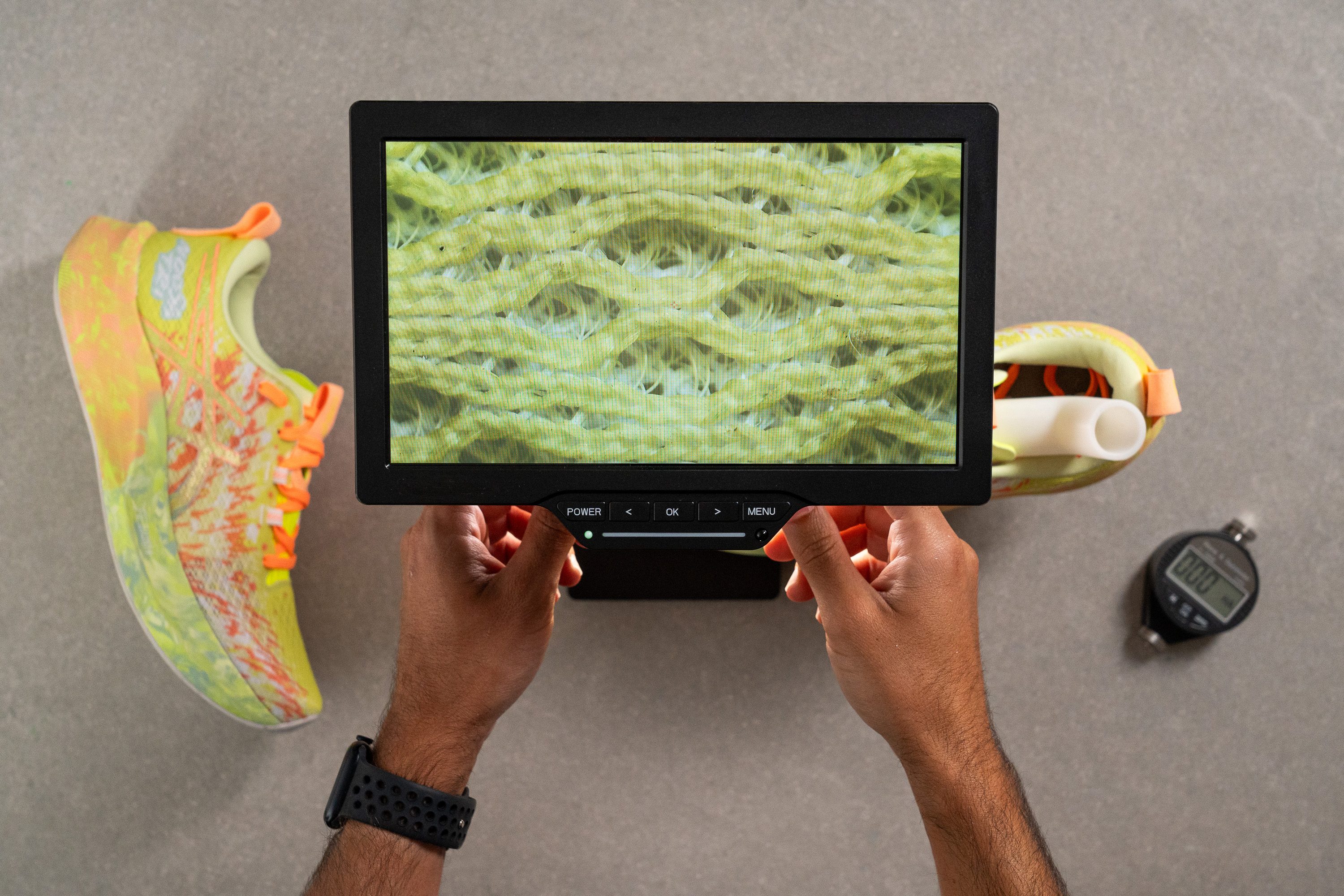
Our examination under the microscope revealed the use of a lightweight engineered mesh, primarily focused on ventilation—an essential feature for triathletes who often compete without socks.
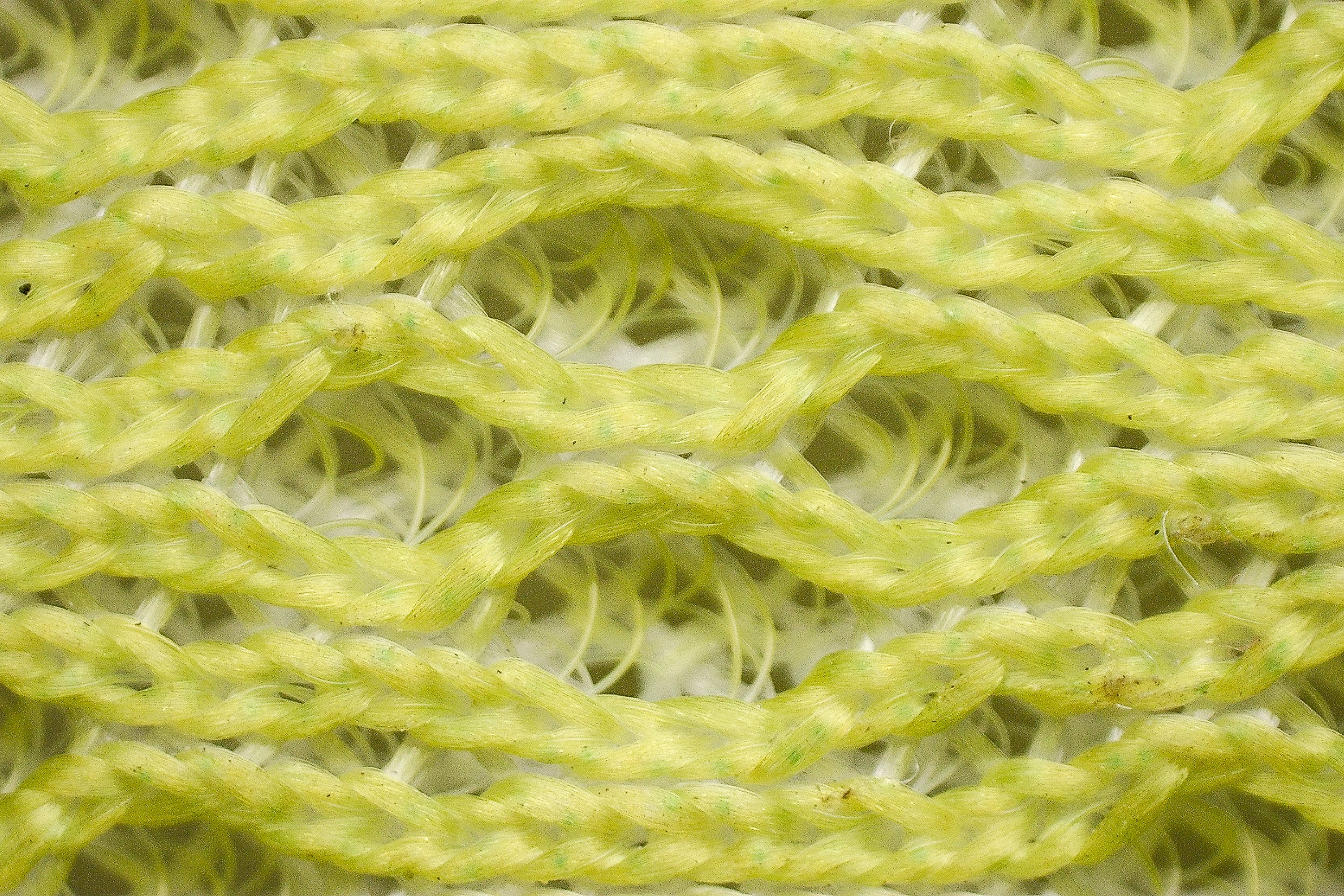
We found that the shoe performs really well for sockless running, though the semi-gusseted tongue's seam might be noticeable for those sensitive to such details.
And whether with thin or thick socks, the shoe delivers exceptional comfort. We were particularly impressed with the heel padding—one of the most comfortable we've ever encountered in any running shoe, regardless of price.
| Noosa Tri 16 | 5 |
| Average | 3.7 |
Stability
Lateral stability test
At first glance, the Noosa Tri 16 appears strictly designed for neutral runners, seemingly unsuitable for those needing even a tiny bit of stability. However, it holds a few unexpected features.
Among these surprises is the 3D Guidance System, which incorporates supportive elements such as midsole sidewalls and sole flare throughout the shoe. This technology, though slightly less pronounced, is the same one used in one of the best mild-stability shoes—the ASICS GT 2000 12.
Torsional rigidity
The enhanced stability of the Noosa Tri series partly stems from its high torsional rigidity, which might surprise newcomers—especially since it doesn't include a carbon plate.
However, this feature is no surprise to us here in the lab. We rated the Tri 15 the highest with a 5-out-of-5 for rigidity, and this latest model has achieved a solid 4/5. In our view, this adjustment is actually a welcome improvement.
| Noosa Tri 16 | 4 |
| Average | 3.5 |
Heel counter stiffness
The heel counter is similar to that of a typical daily trainer, providing a balance of comfort and support that we found quite satisfactory, earning a rating of 3/5. We were particularly pleased with it, especially since it allowed zero heel slippage in our runs.
It's also worth noting that ASICS has redesigned the Noosa Tri 15's flared Achilles area, which some runners found excessive. The new design makes more sense to us.
| Noosa Tri 16 | 3 |
| Average | 2.9 |
Midsole width - forefoot
Throughout this lab review, we've highlighted how nimble and lightweight this shoe feels, a sensation largely due to ASICS maintaining moderate midsole dimensions rather than overextending them.
We discovered a width of 114.9 mm at the broadest point of the forefoot, comparable to that of most daily trainers. In our view, this measurement reaffirms the Tri's balanced design.
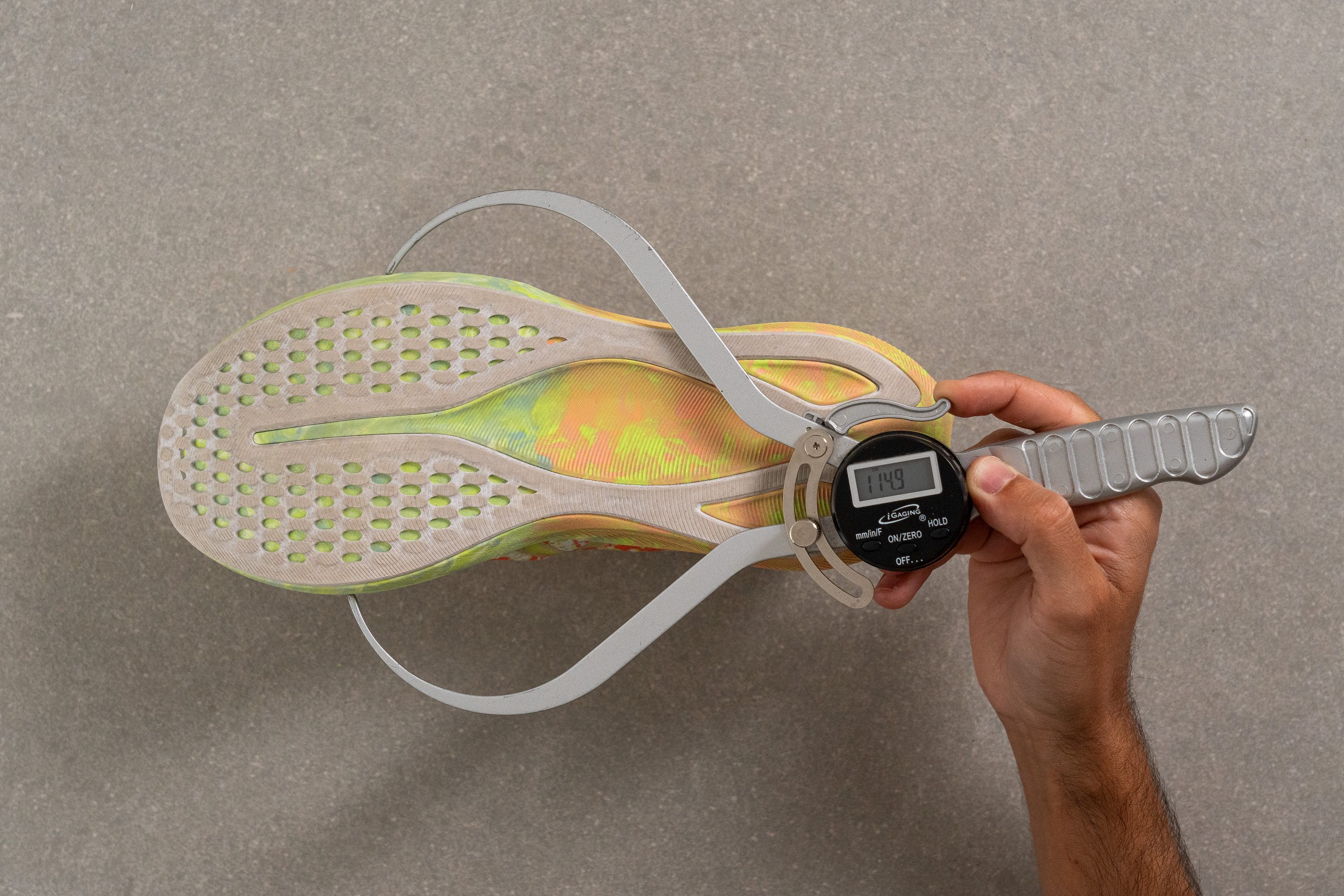
| Noosa Tri 16 | 114.9 mm |
| Average | 114.4 mm |
Midsole width - heel
Similarly, in the heel area, our digital caliper measured 88.6 mm. This dimension positions the shoe comfortably in the middle of the spectrum—not the best choice for those requiring significant support, but wide enough to serve neutral runners exceptionally well.
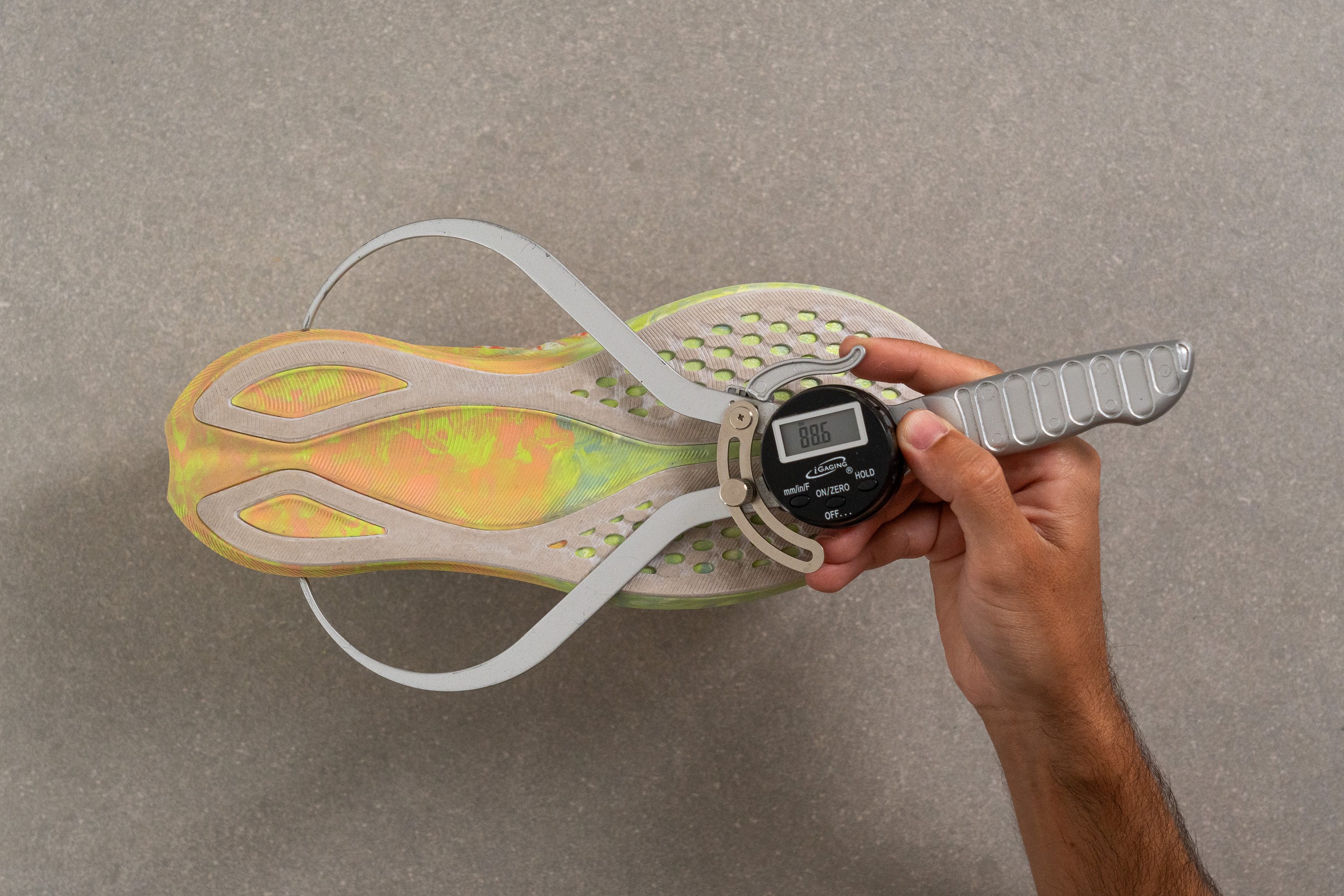
| Noosa Tri 16 | 88.6 mm |
| Average | 90.7 mm |
Durability
Toebox durability
As we all know from life, every action has its consequences, and unfortunately, we uncovered a significant trade-off with the Noosa's upper.
In our standardized test where we use a Dremel on the toebox we observed that it deteriorated remarkably quickly, earning a dismal score of just 1 out of 5.

| Noosa Tri 16 | 1 |
| Average | 2.6 |
Heel padding durability
The heel delivers some encouraging news. In our back-to-back Dremel test, we were really impressed with the durability it demonstrated.
Upon completing the test, we found that the heel padding performed exceptionally well, clearly surpassing the average shoe and earning a strong rating of 4 out of 5.
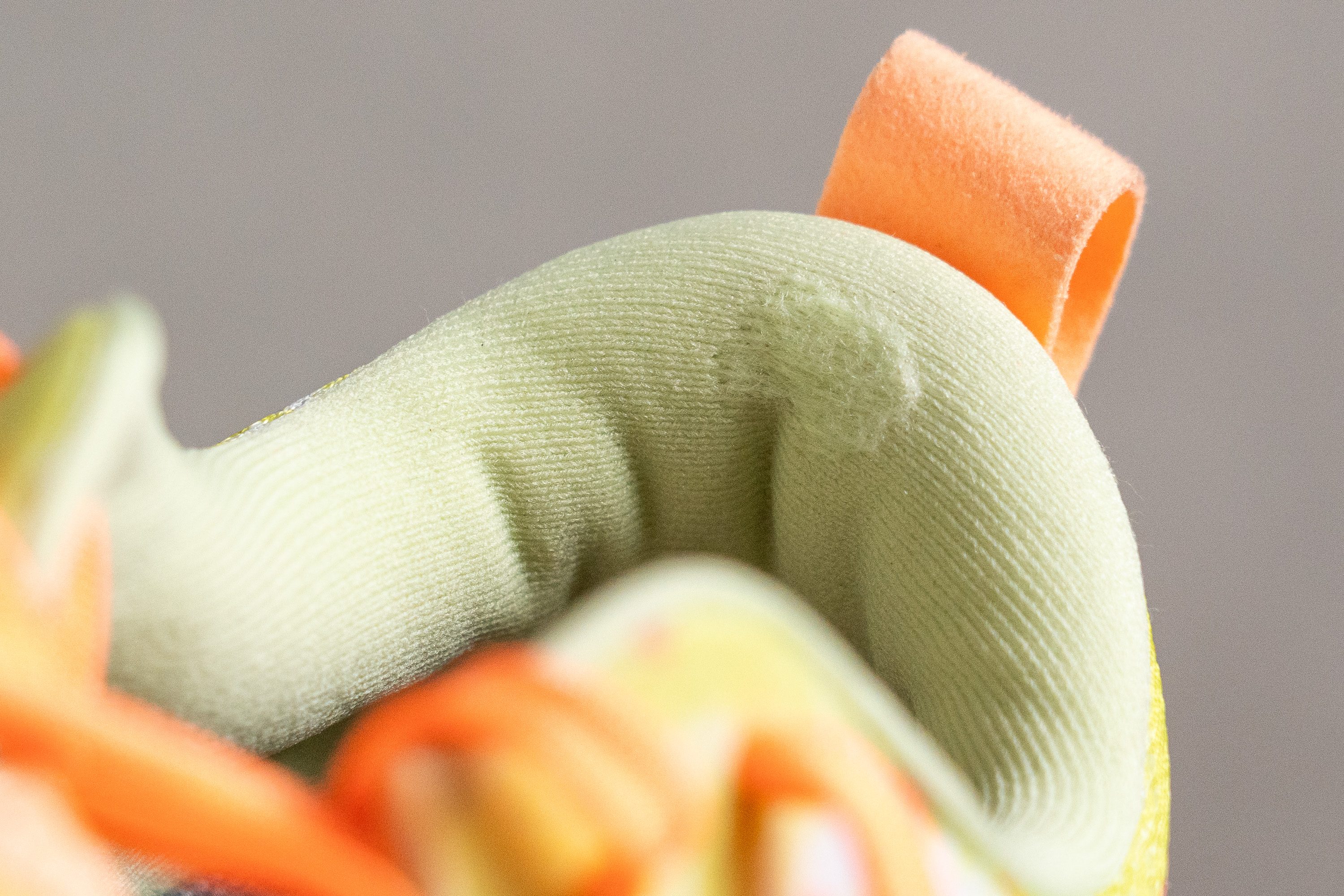
| Noosa Tri 16 | 4 |
| Average | 3.4 |
Outsole durability
It was time to either confirm or alleviate our concerns by using our Dremel for the third and final test in this lab review.
Fortunately, the results were impressive for such soft rubber. With only a minimal indentation of just 1.0 mm, we are confident that although the Noosa Tri 16 isn’t the most rugged tempo trainer on the market, it will last enough.
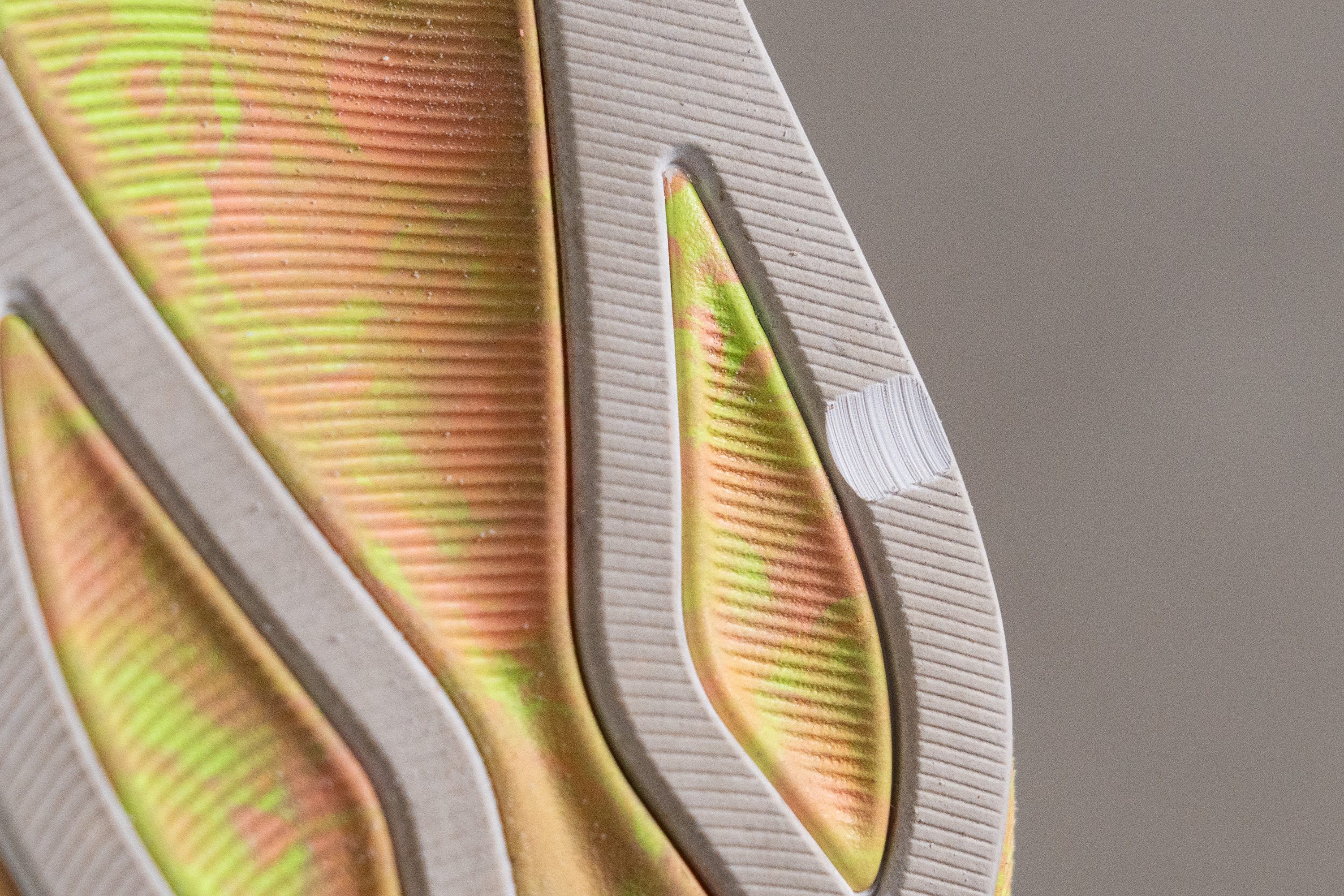
| Noosa Tri 16 | 1.0 mm |
| Average | 1.1 mm |
Outsole thickness
To wrap up our assessment of the outsole, we conducted one final precise measurement of its thickness. At 2.3 mm, we believe ASICS made a wise decision—thin enough to ensure speed and agility, yet thick enough to offer lasting durability.

| Noosa Tri 16 | 2.3 mm |
| Average | 3.2 mm |
Misc
Insole thickness
Unsurprisingly, the EVA insole of the NT16 sports a typical thickness of 4.4 mm. It doesn’t introduce anything out of the ordinary, which, in this case, is a positive thing for us.

| Noosa Tri 16 | 4.4 mm |
| Average | 4.5 mm |
Removable insole
In our lab, we successfully removed the insole and tested the Noosa Tri 16 with various other footbeds. We found that switching them out was straightforward, ensuring that users won't encounter issues with aftermarket options.
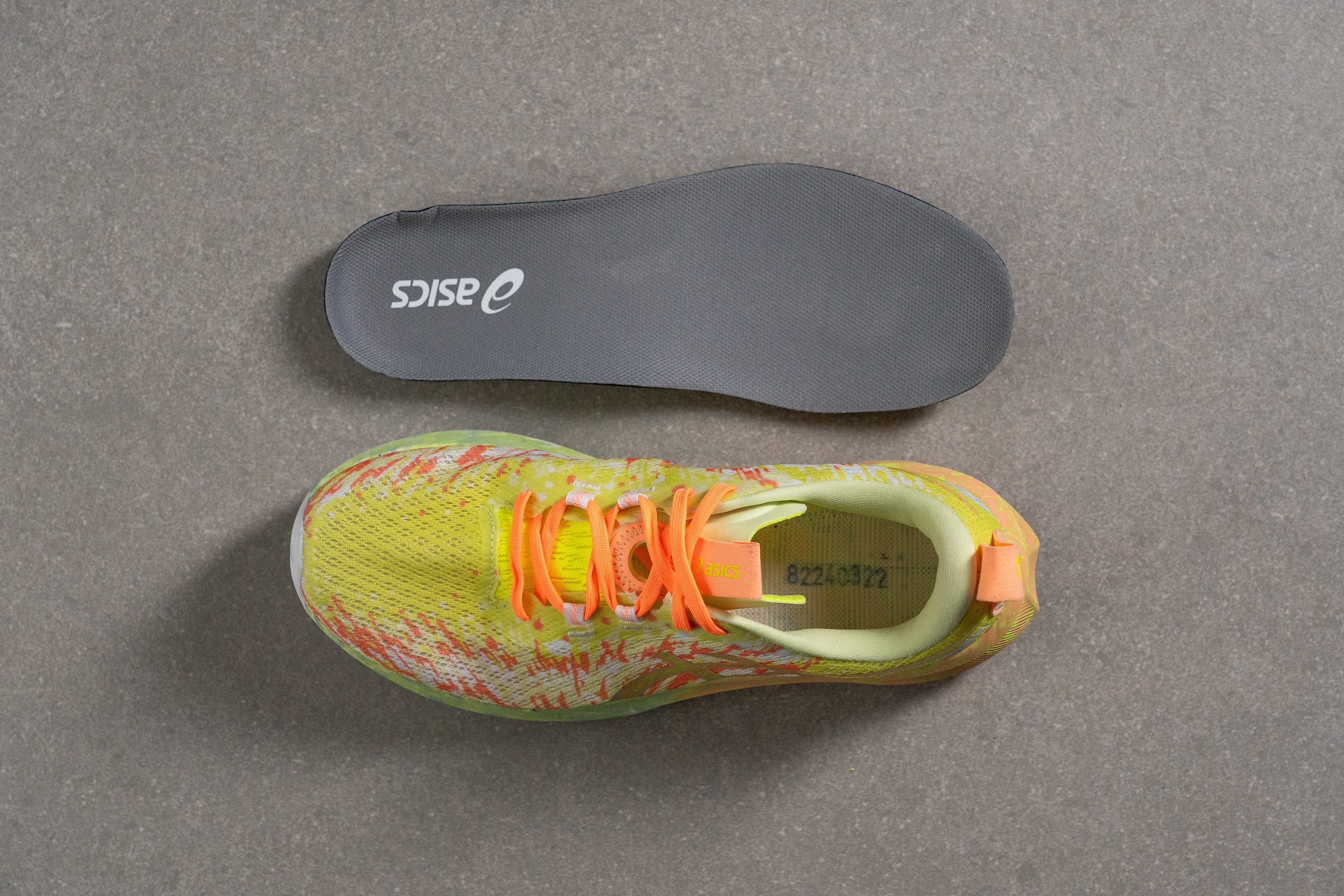
| Noosa Tri 16 | Yes |
Midsole softness in cold (%)
Switching from FF Blast to FF Blast+ has notably enhanced the midsole's performance in cold temperatures too. Previously at a respectable 21% in this 20-minute freezer test, the improvement to an outstanding 6.8% represents a dramatic boost in cold-weather versatility.
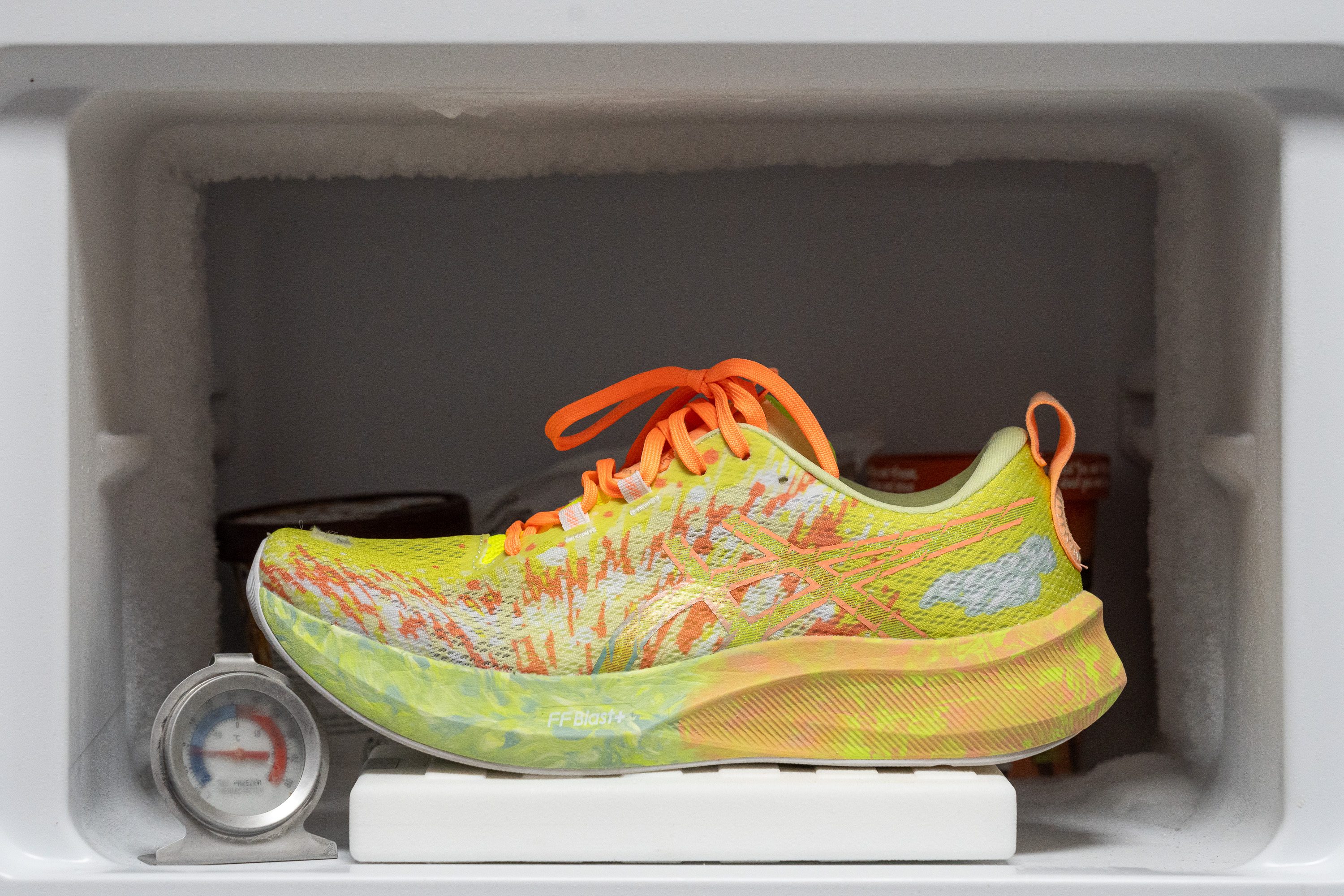
| Noosa Tri 16 | 7% |
| Average | 24% |
Reflective elements
We found that ASICS chose not to include reflective elements in the Noosa Tri 16. We believe that the lack of high-visibility features can be excused this time, given the shoe's affordable price. Additionally, most triathlon runs typically occurs during daylight hours.

| Noosa Tri 16 | No |
Tongue padding
Throughout this lab review, we observed that the Noosa Tri 16 prioritizes being as lightweight as possible, with ASICS focusing heavily on this feature—including the tongue design.
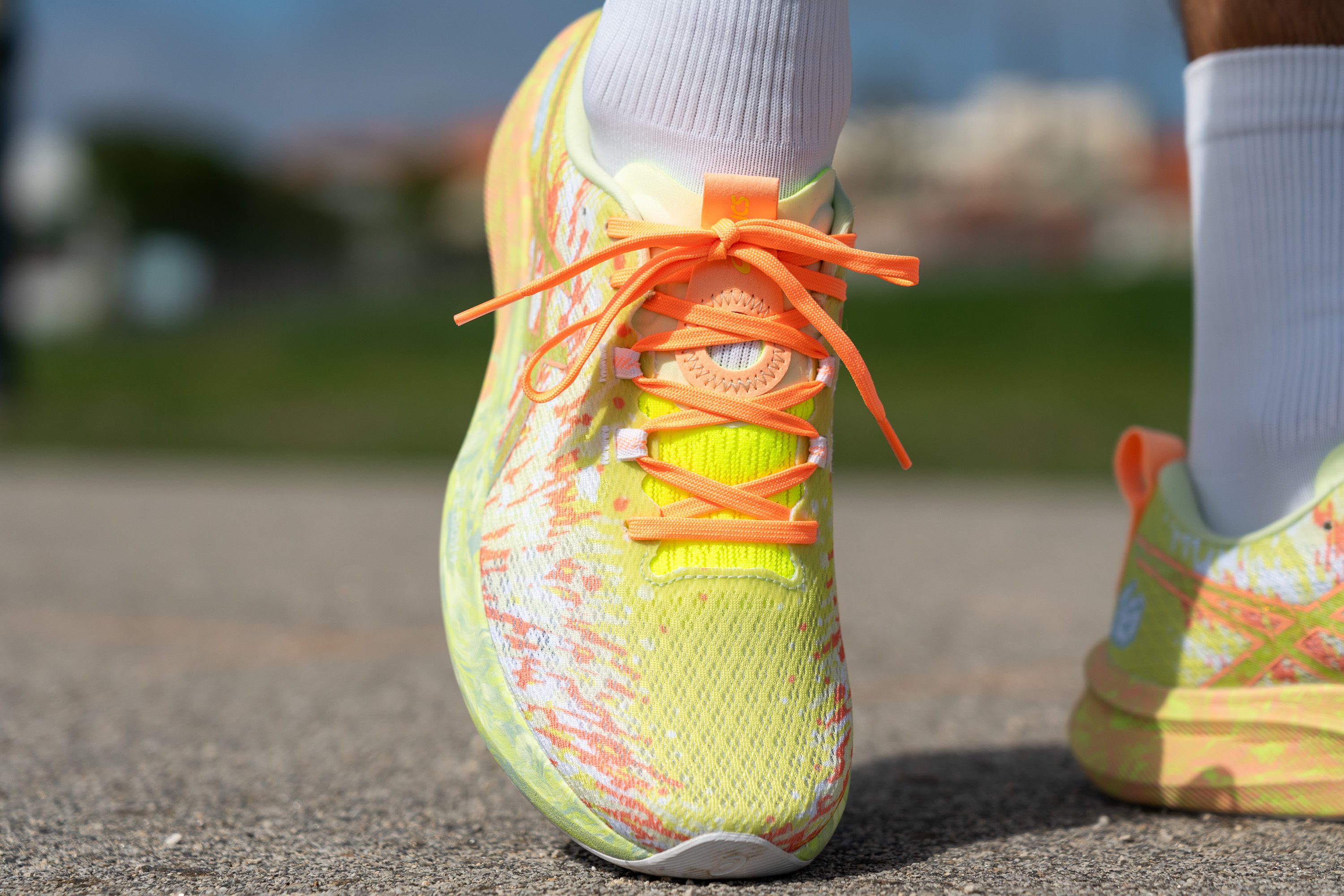
We discovered that the tongue is exceptionally thin, measuring just 1.2 mm in thickness and completely lacking padding. Therefore, we believe it's only suitable for runners who are not susceptible to lace bite.

| Noosa Tri 16 | 1.2 mm |
| Average | 5.8 mm |
Tongue: gusset type
Finding a semi-gusseted tongue in a $135 shoe is quite uncommon, so we were thrilled to discover this feature in the Noosa Tri 16. It offers an excellent lockdown, which is especially beneficial given the Tri's broad upper.
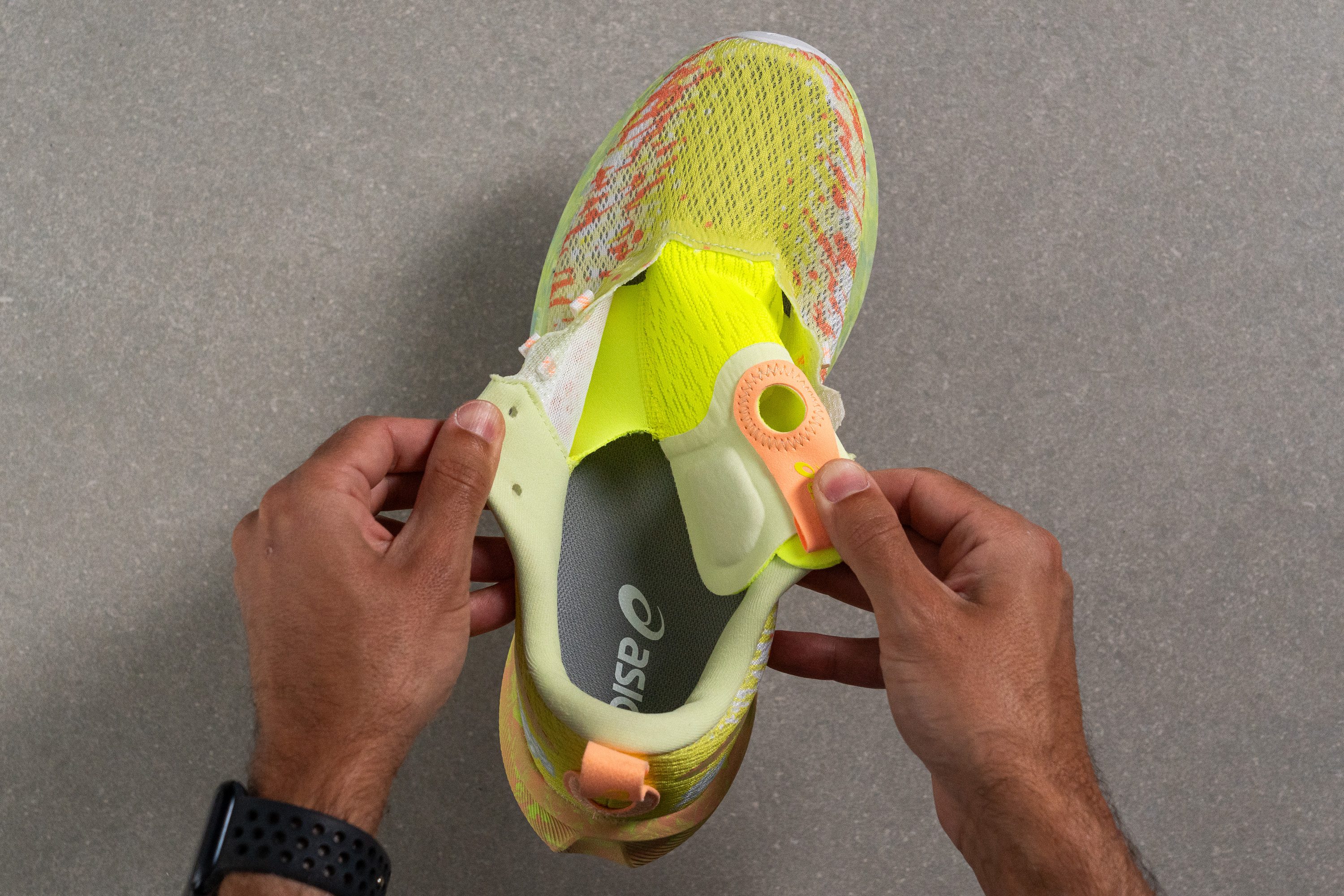
| Noosa Tri 16 | Both sides (semi) |
Heel tab
The heel of the NT16 features a superb finger-loop heel tab. Unlike other running shoes, ASICS excelled in determining the perfect size and placement of this tab. Additionally, they've sewed it exceptionally well to ensure durability and prevent breaking it after some months of use.
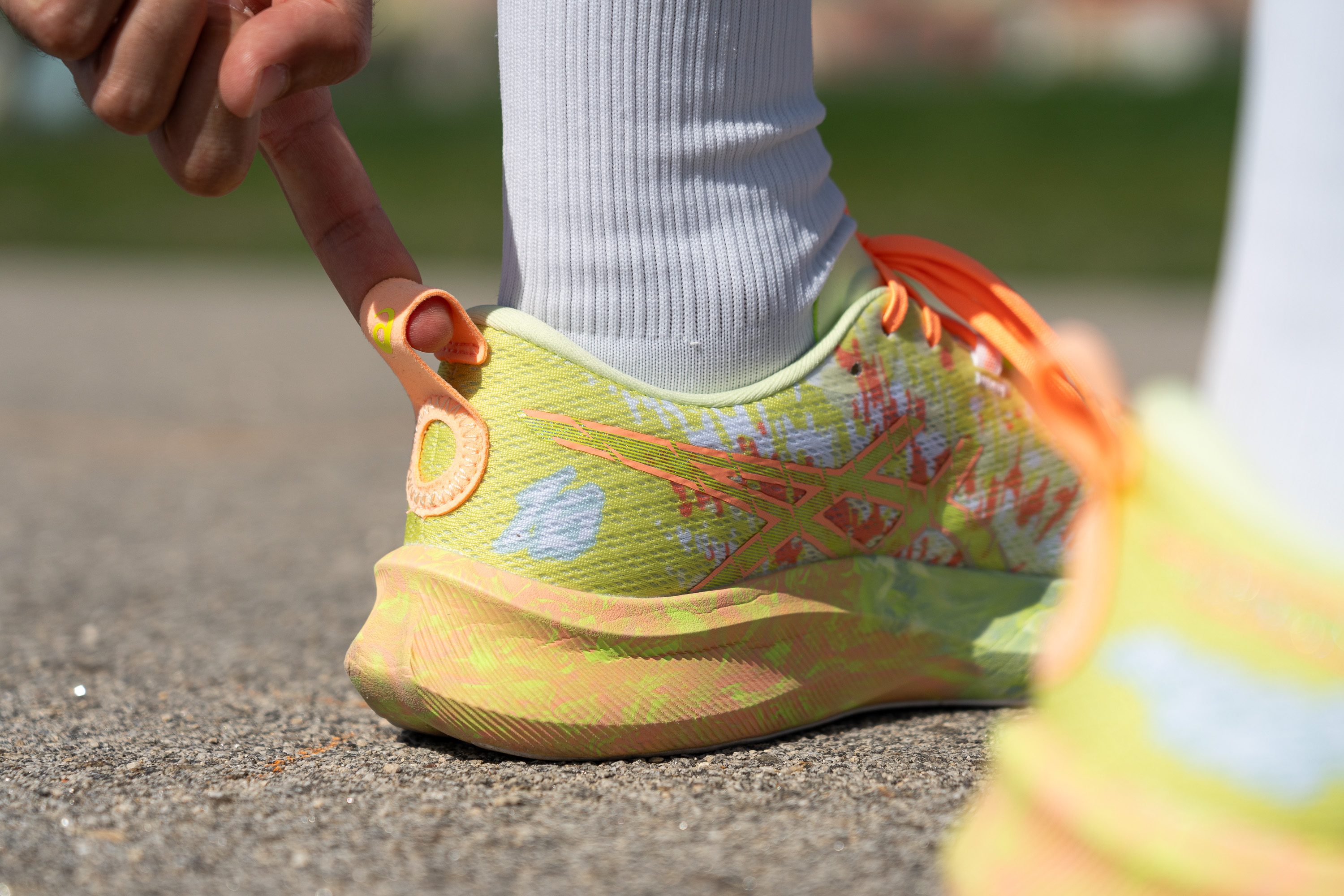
| Noosa Tri 16 | Finger loop |
Tongue tab
Although the rise of supershoes like the Metaspeed Sky Paris has somewhat eclipsed its classic triathlon appeal in recent years, ASICS continues to design the Noosa Tri series with triathletes in mind. And the tongue tab is one of those tiny details that really showcases that.
